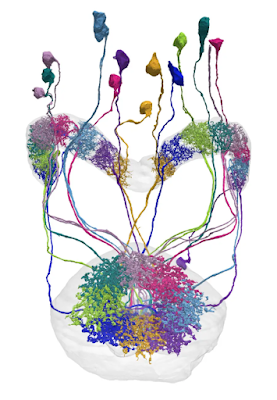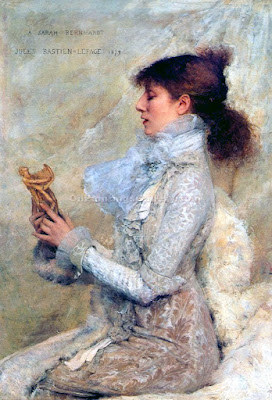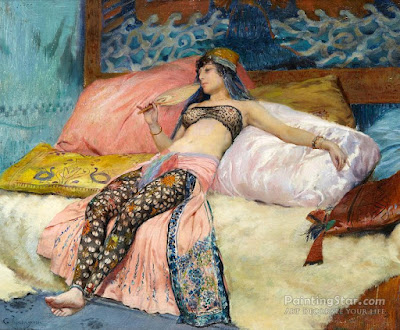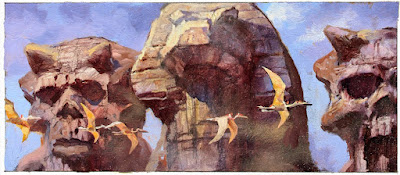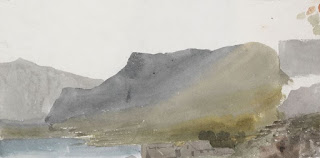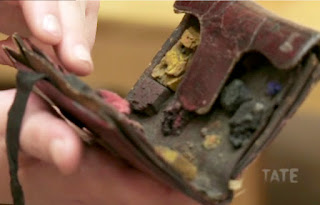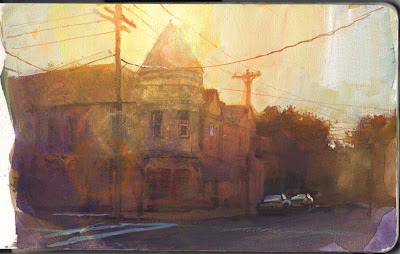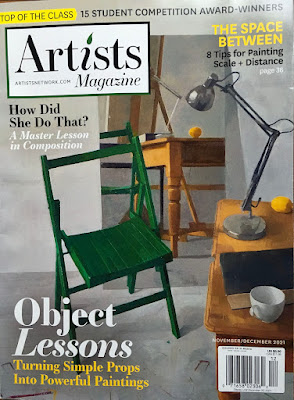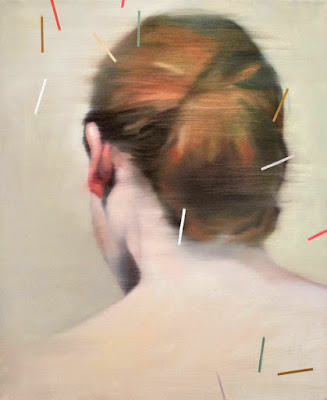Sunday, October 31, 2021
Saturday, October 30, 2021
The Dinotopia CD-Rom Game
In 1996 Turner Interactive produced a CD-Rom game called Dinotopia: Living the Adventure.
This YouTube review by Simone de Rochefort of Polygon explores the history and the gameplay.
We had similar issues dealing with the toy industry. The industry experts would tell us that "boys only want battles." The movie business leaders said the same thing.
Conflict, peril, and risk in some form really is necessary for most games and dramatic presentations, but there are so many ways to present those elements without having the good guys trying to kill all the bad guys.
Friday, October 29, 2021
Spacebiker Aliens
Thursday, October 28, 2021
Mapping the Fruit-Fly Brain
Scientists have succeeded in mapping the neurons and connections of a fruit fly brain.
According to the New York Times, "their speck-size brains are tremendously complex, containing some 100,000 neurons and tens of millions of connections, or synapses, between them....The work, which is continuing, is time-consuming and expensive, even with the help of state-of-the-art machine-learning algorithms. But the data they have released so far is stunning in its detail, composing an atlas of tens of thousands of gnarled neurons in many crucial areas of the fly brain."
Wednesday, October 27, 2021
Paintings of Sarah Bernhardt
Sarah Bernhardt by Paul Merton
Sarah Bernhardt by Georges Antoine Rochegrosse
 Book: Sarah Bernhardt: The Art of High Drama (Yale University Press)
Book: Sarah Bernhardt: The Art of High Drama (Yale University Press) Tuesday, October 26, 2021
Monday, October 25, 2021
Painting Autumn Leaves
Sunday, October 24, 2021
Creature of the Rondout Lagoon
Saturday, October 23, 2021
Artists Collaborate with Museums to Explore Techniques
Watercolor expert Mike Chaplin heads outdoors to demonstrate how J.M.W. Turner may have thought about tone (Link to YouTube). Instead of trying to copy a Turner, he paints directly from nature using materials and methods similar to what Turner might have used. Chaplin teamed with the Tate to produce similar videos with line and color.
Friday, October 22, 2021
Sketching on the Subway

Manhattan thrilled me, terrified me, and fascinated me. I desperately wanted to capture some of NYC's energy directly from life into my sketchbook using pens, and gray markers.
I never went back to art school because I was learning so much more from the real world. Tom and I wrote a book called The Artist's Guide to Sketching in 1982, and that was long before he became the "Painter of Light" and also before "urban sketching" and "plein-air painting" came along.
You can hear a vintage tape recording from that journey on this YouTube video. The quality isn't great, but it's a memory rescued from oblivion.
Thursday, October 21, 2021
Branch Autonomy Theory
By thinking of a tree as an individual organism, we misunderstand it. It's better to think of a tree as a colony of branches.
According to the branch autonomy theory, "1) No branch imports carbohydrate from its parent tree after its first year, and 2) Each branch satisfies its own material and energy requirements before exporting any carbohydrate to the rest of the tree.""The conclusion drawn from these postulates is that where light is the primary limiting factor, critical characteristics of the branch's carbohydrate economy such as photosynthesis, growth, and carbon export are largely independent of the tree to which it is attached." (from the abstract by Sprugel and Hinckley).
The theory is mentioned in a podcast interview with Chris Earle, curator of the Gymnosperm Database.
Wednesday, October 20, 2021
Graphene Protects Paintings from Fading
Read more at Artnet: Can Graphene, a One-Atom Thick ‘Wonder Material,’ Keep Precious Artworks From Fading? Scientists Say It Shows Promise
Tuesday, October 19, 2021
Pipeline of Meaning

Monday, October 18, 2021
Thoughts about Bastien-Lepage from Breton
Sunday, October 17, 2021
Races in Skybax Canyon
Will and Cirrus lead the skybax races around ancient demisaurian monuments near Ebulon in Dinotopia's great desert.
The painting is 3 x 6 inches, oil on board, published in my illustrated adventure Dinotopia: Journey to Chandara (signed copies available in my online store).
Saturday, October 16, 2021
Cornelius Varley's Watercolors
Watercolor can convey a lot of information with simple means.
The studies in this post are by Cornelius Varley (1781–1873), who was a scientific instrument maker by profession. In 1845 he wrote a Treatise on Optical Drawing Instruments.
He painted in watercolor for the pure love of it, creating many of his studies on trips to Wales. This sky study from 1803, making him a very early plein-air practitioner.Friday, October 15, 2021
Turner's Small Watercolor Kits
J.M.W. Turner's super-portable watercolor set consisted of a small set of cake colors in a leather pocket pouch.
He also had slightly larger sets with flasks. This is his paintbox, found in his studio after his death in 1851
(Tate Archive 7315.6)To learn more about 19th century watercolor sets, check out the website whimsie.com or the Tate Archive
Thursday, October 14, 2021
How Sacrificing Detail Can Add Mood
--The Theory and Practice of Water Colour Painting: Elucidated in a Series of Letters
—Jules Breton, The Life of an Artist: An Autobiography, 1890
Wednesday, October 13, 2021
Influential Landscape Painters
When the Artists Magazine asked "Who's a painter that changed the course of landscape painting?" the first name that popped into my mind first was Ivan Shishkin (1832-1898).
Tuesday, October 12, 2021
Outline vs. Tonal Shapes In Face Recognition
Which is more important for face recognition: outline or tonal shapes?
 By contrast, the tonal shapes, even if they're out of focus, are relatively easy to recognize. The experts say:
By contrast, the tonal shapes, even if they're out of focus, are relatively easy to recognize. The experts say: Monday, October 11, 2021
Tête d'expression
It was also the name for a competition held at the French Academy.
Greek statues expressed emotion mainly with the pose of the body, but the officials of the Academy didn't want to neglect the expressive potential of the head itself. The exercise was carried out not only with drawings and engravings, but also with sculpture.
 Source of the initial quote was The Art of Rivalry: Four Friendships, Betrayals, and Breakthroughs in Modern Art
Source of the initial quote was The Art of Rivalry: Four Friendships, Betrayals, and Breakthroughs in Modern ArtSunday, October 10, 2021
Vermeer Restoration Reveals Hidden Cupid
A Vermeer painting has restored to reveal a hidden painting within a painting.
According to Smithsonian, "A recent bout of laboratory testing confirmed that a long-hidden Cupid found in the top right-hand corner of the canvas was painted over not by the Dutch Golden Age artist, but an unknown party who acted decades after Vermeer’s death."
Saturday, October 9, 2021
Arthur Denison and the Sunstone
Arthur is not based on a single person, but he's got a little of my dad in him, and a bit from early explorers that I've read about, such as Sven Hedin and Heinrich Harrar. But it's hard to hold those diverse people in mind, so to define the specific character, I sculpted his head as a small maquette.
From Dinotopia: The World Beneath.
Friday, October 8, 2021
Abstracted Realism
When painters efface the surface of a portrait, they typically leave the eyes in a carefully finished state, both because of the psychological importance of the eyes, and to show that they're capable of painting realistically.
But not always. Sometimes artists deliberately disrupt the mouth, eyes, or head.
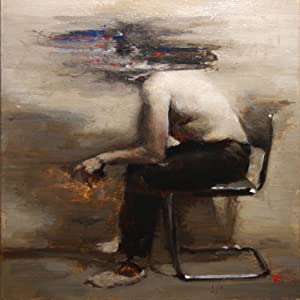
Artist Zack Zdrale says in the book Disrupted Realism, "I've taken passages of traditionally rendered figures and smashed them, breaking the illusion of form in space. I want to show the paint doing things that only paint can do."
Michelle Kohler
Michelle Kohler says: "Most of my years spent studying were focused on portraiture, as expressed through realism. As an artistic discipline, it has been a constant throughout my life. But it was only after a fortuitous departure into abstract painting that I was able to playfully and courageously combine two disciplines. Deconstructed Realism is my expression of artistic independence and creativity as it pertains to the depth and complexity of human portraiture."
(Link to YouTube) Mia Bergeron says that her approach to painting grew out of a frustration with the academic approaches to realism.
The deconstructive approach includes not just figural work, but also landscapes and cityscapes.
Other artists that you've suggested to check out in the comments: Julie T. Chapman, Patrick Kramer, Jenny Saville,
Book: Disrupted Realism: Paintings for a Distracted World











